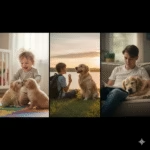More Than Just Obedience: Building a Shared Language of Love
When we first brought our Golden Retriever, Leo, home, I knew training was essential. But as a busy parent, the idea of carving out dedicated training time felt like adding another impossible task to an already overflowing plate. Then, I had an epiphany: what if training wasn’t just my job? What if it could be a shared adventure, a way for my children to not only learn responsibility but to forge an even deeper, more meaningful connection with their new furry family member?
This shift in perspective changed everything. Suddenly, training wasn’t a chore; it was “Team Leo Training Time.” My kids, then ages five and eight, went from being passive observers to active participants, and in doing so, they developed a profound sense of ownership and understanding. This isn’t just about getting your Golden to sit or stay; it’s about teaching your children how to communicate respectfully with an animal, how to be patient, and how to understand the rewards of positive reinforcement. It’s about building a shared language of love and trust that transcends species.
Here, I’m going to share the five foundational commands we focused on first, along with the specific, kid-friendly strategies that made “Team Leo” a smashing success.
The Core Philosophy: Positive, Patient, and Playful
Before we dive into the commands, let’s establish our guiding principles. When kids are involved, training must be:
- Positive: We only reward good behavior. There’s no room for scolding or harsh corrections, especially when a child is participating. We want the dog to associate the child with good things (treats, praise, gentle play).
- Patient: Kids have short attention spans, and puppies have even shorter ones. Sessions are brief (2-5 minutes, max) and frequent. We celebrate tiny successes and never get frustrated by mistakes.
- Playful: We make it a game! This keeps both the kids and the dog engaged and makes learning fun.
Remember, your children are learning how to teach while the dog is learning what to do. It’s a double lesson in patience and communication.
Command 1: “Sit” – The Gateway to Good Manners
“Sit” is the first and arguably most important command. It’s a polite greeting, a calm waiting position, and a foundation for almost every other behavior. It teaches impulse control in a simple, understandable way.
How We Taught It (Kid-Friendly Style):
- The Lure Method: I taught my kids to hold a small, high-value treat (like a tiny piece of cheese or cooked chicken) at Leo’s nose. Then, they slowly moved the treat back over his head, guiding his nose up and causing his rear end to naturally drop to a sit. The instant his rear touched the ground, the treat was given with an enthusiastic “YES! SIT! Good boy!”
- The “Magic Word”: We practiced saying “Sit” as his bottom touched the floor, creating that verbal association.
- Kid’s Role: My kids were primarily responsible for the treat delivery and the enthusiastic praise. They learned to time it perfectly. When Leo offered a sit, they would erupt in praise, “Good SIT, Leo! You did it!” This made Leo associate sitting with happy kids and delicious treats.
- “Sit for Everything”: Once he grasped it, we integrated “Sit” into daily life. Before opening the door for a walk, “Sit!” Before getting his dinner bowl, “Sit!” Before getting a belly rub from a child, “Sit!” This taught the kids that politeness earns rewards.
Command 2: “Come” – The Life-Saving Recall
“Come” is the most critical safety command. It can prevent your Golden from running into traffic, chasing after a squirrel, or getting lost. Teaching this as a fun, rewarding game is paramount.
How We Taught It (Kid-Friendly Style):
- The “Puppy Party” Game: This was a favorite. One child would stand a few feet away with a treat. I’d hold Leo gently. The child would excitedly say, “Leo, COME!” in a happy, high-pitched voice, then crouch down and open their arms wide, making themselves small and inviting. The instant I released Leo, he’d bound to the child, get his treat, and receive a massive amount of happy praise and gentle scratches.
- The “Ping Pong” Game: As he got better, we’d play “Come” with two people. My husband and I would stand opposite each other with the kids. One person would call Leo, reward him, and then the other person would call him. The kids loved being the “callers” and the “rewarders.”
- Never Punish a Come: This was a strict rule: if Leo eventually came to us (even if it was after a long chase), he was always rewarded and praised. We never scolded him, because we wanted him to associate coming to us with only good things. The kids understood that “Come” meant happy times, not trouble.
Command 3: “Stay” – The Power of Patience
“Stay” teaches impulse control and patience, which are valuable skills for both your Golden and your children. It’s a slightly more advanced command, so we introduced it after “Sit” and “Come” were solid.
How We Taught It (Kid-Friendly Style):
- Start Small: We began with Leo in a “Sit” position. I’d tell my child to say “Stay!” in a firm but calm voice, holding up an open palm as a hand signal. Then, they’d take one tiny step back, count to “one Mississippi,” step forward, and immediately reward with a treat and praise.
- Gradual Increase: Slowly, we increased the distance (a few steps) and the duration (a few seconds). The kids learned that if Leo broke the “Stay,” they would simply calmly reset him to his “Sit” position and try again, without any fuss.
- Kid’s Role: My kids learned the power of the verbal command and the hand signal. They also learned that patience on their part yielded patience from Leo. Their biggest challenge was resisting the urge to call him to them too early! This taught them self-control.
Command 4: “Off” – Curbing Jumping & Paws-On Behavior
Golden Retrievers are notoriously enthusiastic greeters. While their jumping is a sign of joy, it can be dangerous for small children or elderly visitors. “Off” is our command to tell them to keep four paws on the floor.
How We Taught It (Kid-Friendly Style):
- The “No Paws Up” Rule: I explained to my children that while Leo loves us, we can’t let him jump because it might hurt little kids or grandma. We always practiced this when Leo was calm.
- Turn and Ignore: If Leo jumped on a child, the child was taught to calmly (no yelling!) turn their back, cross their arms, and completely ignore him until all four paws were on the ground. The moment all paws were down, they could turn back and offer a gentle pet or a quiet “Good off!”
- Rewarding Four Paws: I would have my kids offer a treat when Leo greeted them calmly, with all four paws on the ground. This reinforced the desired behavior. The kids quickly understood that calm greetings led to attention and treats, while jumping led to being ignored.
Command 5: “Leave It” – Protecting from the Unseen
This command is invaluable. “Leave It” means “don’t touch that tempting thing on the ground/counter/in your mouth.” It protects your Golden from ingesting something dangerous and protects your kids’ toys from being chewed.
How We Taught It (Kid-Friendly Style):
- The “Two Treat” Game: This is a fantastic way to teach kids the concept of rewarding self-control.
- I’d put a low-value treat (like a piece of kibble) on the floor and cover it with my hand.
- When Leo tried to get it, I’d say “Leave It!”
- The instant he looked away from my hand, I’d say “Yes!” and immediately reward him with a much higher-value treat from my other hand.
- My kids’ job was to excitedly point to the high-value treat and say “Leo, get the GOOD treat!”
- Generalizing the Command: Once he understood the concept, we’d practice with random objects my kids would “accidentally” drop on the floor (under my supervision, of course!). If Leo moved toward it, I’d have my child say “Leave It!” and then guide Leo away with a praise and a treat. This taught my kids the power of the command in real-life scenarios.
Conclusion: The Unspoken Gifts of Training Together
Involving my children in Leo’s basic training didn’t just give us a well-behaved dog; it gave my kids a profound understanding of responsibility, empathy, and positive communication. They learned that patience and kindness yield far better results than frustration. They saw firsthand that their actions had a direct impact on their dog’s behavior, fostering a sense of pride and connection.
These aren’t just commands; they are threads in the tapestry of a family’s life with a Golden Retriever. And when woven together by little hands and a big heart, they create a bond that is truly golden.
A Real-Life Tip: One of the most effective tricks for keeping my kids engaged during training sessions was using a “Clicker” (a small device that makes a distinct clicking sound). I’d be the one with the clicker and the primary treats. When Leo did something right, I’d click, and then my kids would immediately follow with their own praise and a small, approved treat. The clicker marked the exact moment of correct behavior, and the kids’ involvement made it a team effort. They loved being part of the “scientific” precision of dog training!

Rafael Souza is a digital marketing strategist and lifelong dog enthusiast. Passionate about Golden Retrievers, he shares practical, research-based tips to help owners provide healthier and happier lives for their furry companions.





